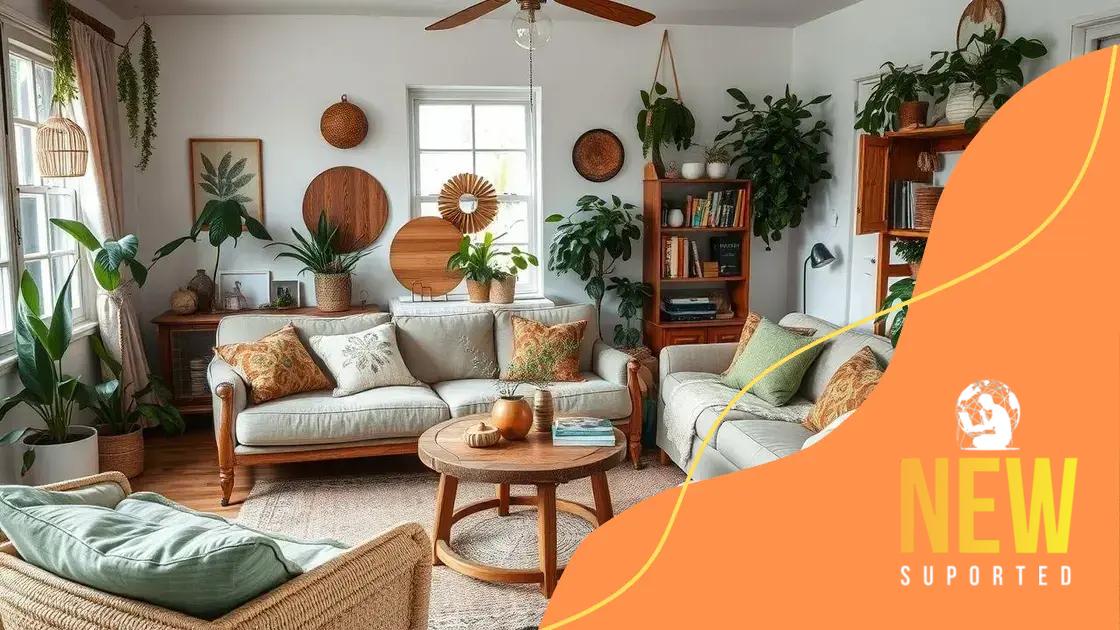Decorating with sustainable and upcycled materials made easy

Decorating with sustainable and upcycled materials significantly reduces waste, conserves natural resources, and promotes environmental stewardship, creating unique and eco-friendly living spaces.
Decorating with sustainable and upcycled materials is a fantastic way to enhance your living space while being kind to the planet. Have you ever thought about how much waste ordinary decor can create? With a little creativity, you can create beautiful, eco-friendly design solutions that tell a story.
Why choose sustainable materials for decoration?
Choosing sustainable materials for decoration is becoming increasingly popular. Not only do these materials reduce waste, but they also promote a healthier living environment. By utilizing sustainable options, you contribute to environmental preservation while also expressing your style.
Benefits of Sustainable Materials
Sustainable materials offer numerous benefits that can transform your space. These materials often come from renewable resources and have lower environmental impacts compared to traditional materials. Here are a few key advantages:
- Reduced carbon footprint
- Durability and longevity
- Unique aesthetics
- Support for local artisans
Moreover, decorating with sustainable materials can lead to significant savings in the long run due to their durability. For instance, upcycled furniture not only tells a story but also adds a distinctive charm to your home.
Healthier Home Environment
Using sustainable materials often results in a cleaner indoor environment. Many traditional decorations contain harmful chemicals. In contrast, eco-friendly options typically use non-toxic finishes and natural fibers that promote indoor air quality. Imagine the peace of mind that comes with a home filled with safe and sustainable choices.
Moreover, by incorporating plants and natural textures into your decor, you can create a calming atmosphere that enhances well-being. Sustainable decorating is not just about looks. It’s also about how these materials affect your life and health!
In conclusion, the choice of sustainable materials in your decor can lead to a more appealing, healthier, and environmentally friendly home. Think about the benefits this decision brings not only to you but also to the planet.
Creative upcycling ideas for your home
Upcycling is a fantastic way to give new life to old items in your home. By transforming unwanted objects into unique decor pieces, you not only save money but also reduce waste. Here are some creative ideas to inspire your upcycling journey.
Transform Furniture
Old furniture can be a goldmine for upcycling. For example, an old dresser can become a stylish TV stand with a fresh coat of paint. Likewise, wooden pallets can be transformed into outdoor seating or coffee tables. The possibilities are endless!
- Paint or stain old furniture to match your decor.
- Add new hardware to dressers and cabinets for a modern look.
- Use old doors as a unique headboard.
- Combine several crates to create a bookshelf.
These transformations not only enhance the aesthetic of your home but also create conversation pieces that reflect your style.
Repurpose Household Items
Many everyday items can be repurposed creatively. For instance, glass jars can serve as beautiful vases or storage containers. You can also use old frames for art displays or create a gallery wall. This approach adds character to your space and showcases your creativity.
Old books can be stacked to create charming side tables, and wine bottles can become candle holders or decorative elements. Everybody loves a good DIY project!
Think about what you already own—where can you be more creative? Upcycling allows you the freedom to experiment and discover new uses for items that might otherwise be discarded.
Gardening and Outdoor Decor
Upcycling ideas aren’t limited to indoor spaces. You can transform old tires, for example, into vibrant planters. They can be stacked or painted bright colors to create fun outdoor seating. To give your garden a unique touch, consider converting an old ladder into a vertical planter. Simply lean it against a wall and fill the steps with plants.
The joy of upcycling lies in the creativity it inspires. The next time you consider tossing something, think of the potential it holds. With a bit of imagination, you can create stunning decor that not only looks good but also tells a story.
Tips for sourcing eco-friendly materials

Sourcing eco-friendly materials for your decorating projects is a vital step towards creating a sustainable home. By making conscious choices, you can minimize your environmental impact while enhancing your living space. Here are some practical tips to help you find the right materials.
Research Local Sources
Start by looking for local suppliers who specialize in sustainable products. Many communities have shops dedicated to eco-friendly materials, including reclaimed wood, bamboo, and recycled metal. Buying locally not only supports your community but also reduces transportation emissions.
- Visit farmer’s markets for local wood and handmade goods.
- Check out local salvage yards for unique reclaimed items.
- Look for eco-friendly home improvement stores.
- Connect with local artisans who create sustainable pieces.
These local resources can offer a variety of options that suit your taste and budget.
Evaluate Material Certifications
When purchasing materials, it’s important to look for certifications that ensure they are truly sustainable. Products labeled with certifications like FSC (Forest Stewardship Council) for wood or LEED (Leadership in Energy and Environmental Design) for building materials indicate environmentally responsible practices. Being informed about certifications can help you make better choices.
In addition to certifications, ask suppliers about the origin of their materials and their production processes. This transparency will empower you to choose products that align with your values.
Explore Online Platforms
Numerous online platforms cater to eco-conscious consumers looking for sustainable products. Websites specializing in eco-friendly building materials often provide a wide array of options from around the world. You can find everything from natural paints to recycled glass.
Online shopping can be a convenient way to compare different materials and find the best prices. Just ensure that you check reviews and the sustainability criteria of the brands you select.
Repurpose and Upcycle
Don’t overlook the potential of repurposing and upcycling old items. Visit thrift stores, garage sales, and flea markets to find unique pieces that can be transformed into beautiful decor. With a little creativity, these items can serve new purposes in your home.
Keep an open mind when searching for materials. Sometimes, the best finds are hidden treasures waiting for a little imagination to bring them back to life.
How to incorporate sustainable decor in any room
Incorporating sustainable decor in any room can transform your living space while being environmentally friendly. With a few thoughtful choices, you can create an inviting atmosphere that reflects your commitment to sustainability.
Color Schemes and Natural Materials
Start by selecting a color scheme that evokes a natural feel. Earthy tones like greens, browns, and beiges can make your space feel calming and cozy. Incorporate materials like bamboo, reclaimed wood, or organic cotton for furniture and textiles. These materials not only look great but are also sustainable choices that minimize environmental impact.
- Consider using eco-friendly paint with low VOCs to reduce indoor air pollution.
- Add natural fiber rugs to enhance warmth and texture.
- Use bamboo or cork for flooring options.
- Opt for glass or metal decor items to ensure longevity.
Integrating these materials into your decor can refresh any room while supporting eco-friendly practices.
Greenery and Plants
Adding plants is a key element in sustainable decor. Houseplants improve air quality and bring life to your space. Choose native plants that require less water and upkeep. Herbs, succulents, and pothos are excellent options that thrive indoors.
Arrange plants in pots made from recycled materials or biodegradable options. Hanging plants can also save space and create a vibrant atmosphere. By including greenery in your rooms, you contribute to a healthier environment.
Thoughtful Accessories
Accessorizing with sustainable products can make a significant difference. Look for handmade items or artisanal crafts that support local artisans. These pieces often tell a story and add character to your decor.
You can also repurpose old items into new decor. For instance, turn vintage jars into candle holders or use old fabric for cushion covers. Thoughtful accessories can showcase your personality while being eco-conscious.
Lighting Choices
Lighting is another crucial aspect of sustainable decor. Choose energy-efficient LED bulbs to reduce electricity consumption. Natural light is ideal, so consider sheer curtains to let sunlight in. You can also install skylights to brighten up the room while minimizing the need for artificial lighting.
The right lighting can enhance the mood of any room while being environmentally friendly.
The impact of upcycled decor on the environment
Upcycled decor plays a crucial role in promoting environmental sustainability. By repurposing old materials and items, you effectively extend their lifespan and keep them out of landfills. This practice not only reduces waste but also conserves natural resources.
Reduction of Waste
When upcycling, you are giving a second life to items that might otherwise be discarded. This process helps decrease the amount of waste that ends up in landfills. Every piece of furniture or decor that is salvaged prevents more waste from contributing to environmental damage.
- Using upcycled materials reduces the need for new products.
- Every item reused can significantly lessen pollution.
- It lowers the demand for landfill space.
- Upcycling also helps reduce manufacturing waste.
As you can see, the act of upcycling not only minimizes waste but supports a greener planet for future generations.
Conservation of Resources
Upcycling decor conserves valuable resources. Instead of harvesting new materials, the focus is on using what already exists. This conservation reduces the strain on forests and natural habitats, allowing ecosystems to thrive.
Moreover, manufacturing new products requires energy and water. By upcycling, energy consumption and water use are greatly diminished, leading to a smaller carbon footprint. This is crucial in the fight against climate change.
Encouragement of Sustainable Practices
Promoting upcycled decor encourages a shift towards more sustainable practices in daily life. When people see the beauty and functionality of upcycled items, they are inspired to make similar choices. This fosters a culture of sustainability and creativity.
Upcycling also helps raise awareness about the importance of environmental stewardship. People start valuing what they have, leading to mindful consumption and reducing the habit of buying new items.
Community Impact
Supporting local artisans who create upcycled decor can boost local economies. Buying from local creators not only fosters community spirit but also strengthens the market for sustainable products.
Through workshops and community events focused on upcycling, individuals can learn valuable skills. This exchange of knowledge not only promotes sustainability but creates bonds within the community.
Conclusion: Incorporating sustainable decor and embracing upcycling can make a significant positive impact on the environment. By repurposing old items, we minimize waste, conserve resources, and inspire others to adopt eco-friendly practices. The beauty of sustainable decor is that it not only enhances our living spaces but also promotes a culture of mindfulness and creativity. Every small change we make contributes to a healthier planet, one decor piece at a time.
FAQ – Frequently Asked Questions about Sustainable Decor and Upcycling
What is upcycling and why is it important?
Upcycling is the process of repurposing old items into new decor, which helps reduce waste and conserve resources. It’s important for promoting sustainability and creativity.
How can sustainable decor benefit my home?
Sustainable decor enhances your home’s aesthetic while being environmentally friendly. It reduces your carbon footprint and supports local artisans.
What materials are best for eco-friendly decorating?
The best materials include reclaimed wood, bamboo, organic fabrics, and recycled metals. These options are sustainable and often more unique than conventional materials.
How can I start upcycling in my home?
You can start by looking for items you no longer use and getting creative with their repurposing. Consider workshops or tutorials to learn new techniques and ideas.






